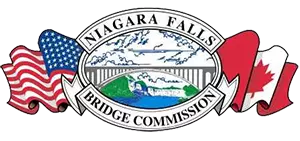
FOR IMMEDIATE RELEASE: October 14, 2020
For further information contact:
Matt Davison
716.604.7772
matt@martingroupmarketing.com
Lewiston Plaza Modernization Project Reaches Major Milestone with Completion of Enhanced 32,000 Square Foot Processing Facility
Relocation of U.S. Customs and Border Protection operations underway
LEWISTON, NY – Today the Niagara Falls Bridge Commission (NFBC) announced a major milestone has been reached in the Lewiston Plaza Modernization Project with the completion of the U.S. Customs and Border Protection Auto and Bus processing facility.
The upgrade to the Lewiston border facility is designed to enhance the efficiency and functionality at one of the busiest points of entry along the U.S.-Canada border. Phase II work commenced in August 2018. This portion of the project included the construction of a new 32,000 sq. ft. auto and bus processing facility, 6,000 sq. ft. secondary inspection canopy, and dedicated bus lane. Previously completed in 2016, the first phase saw the relocation of Interstate 190, major utilities, and the Duty-Free Shop at a cost of $21 million (USD).
“The Lewiston-Queenston Land Port of Entry is not only critical to the economies of Western New York and Southern Ontario, but also to the greater U.S.-Canada relationship,” said Kenneth Bieger, NFBC CEO. “This new facility is a true testament to the hard work of the Commission, our construction partners, and fellow colleagues at both U.S. Customs and Border Protection and the U.S. General Services Administration. In addition, we’re appreciative of the support and assistance provided by U.S. Senator Charles Schumer and other key elected officials in helping to prioritize these projects and improve the overall travel experience for commuters, tourists, residents, and businesses alike.”
“It has been incredible to witness the progress of this important revitalization initiative. We look forward to continued collaboration with all entities involved as we work towards the completion of these tremendous infrastructure upgrades that will result in efficient, world-class operations at our border,” said Mike Goodale, NFBC Chairman.
“The revitalization of the Lewiston-Queenston port of entry is a critical investment in the efficiency and security of the U.S.-Canadian border,” said U.S. Senator Chuck Schumer. “Millions of vehicles from both sides cross this bridge annually, and by making travel easier and more efficient, we can ensure continued economic benefit from commuters, commercial movements, travel, and tourism for the Western New York community and beyond.”
As work continues on Phase II, the focus will be on the demolition of the previous 5,000 sq. ft. inspection facility to allow for the construction of new primary inspection lanes. In total, 15 new lanes will be installed, including nine dedicated auto lanes, five high-low lanes that can process both trucks and autos based on demand, and one lane dedicated solely to the processing of commercial trucks. The expected completion of the $91 million Phase II project will occur in the spring of 2023.
“Our officers are already recognizing the vast improvement to our operations as we transition to the new inspection facility,” said Jennifer De La O, Port Director of the Port of Buffalo. “The upgrade from 5,000 sq. ft to a modern 32,000 sq. ft. hub will significantly improve our processing abilities and allow for more efficient and effective delivery of our important mission at the border. We look forward to the full completion of the plaza effort and will continue to work with our trusted partners.”
The Lewiston-Queenston Land Port of Entry (LPOE) located in Lewiston, New York, is the fourth-busiest commercial land crossing between the United States and Canada. Constructed in 1962, the bridge is 370 feet above the Niagara River and connects United States Interstate 190 with Canadian Highway 405. 1,600 feet in length, the bridge and its five reversible lanes support over 2.6 million passenger vehicles and over approximately 800,000 commercial trucks annually.
“Having an easy, safe, and welcoming experience at the border is incredibly important to our regular commuters and visitors on both U.S. and Canadian sides,” said John Percy, president and CEO at Destination Niagara USA. “This new facility will be a beneficial asset to ensure a secure and convenient crossing at a busy port of entry, encouraging repeated use and return visits to enjoy the many amenities and recreation opportunities in our community.”
The Lewiston LPOE modernization project on the U.S. side of the border will complement the Queenston Plaza renovation, which was completed in 2011. The Canadian facility upgrade included a new primary customs processing facility, elevated parking structure, toll complex, and more.
About the Niagara Falls Bridge Commission:
The Niagara Falls Bridge Commission is a unique, bi-national body. Canada and the U.S. are equally represented on the NFBC through the bi-national appointment of an eight-member Board of Commissioners. A Joint Resolution of the 1938 U.S. Congressional Third Session created the framework for the NFBC. In 1939, the Province of Ontario, Canada licensed the NFBC under The Extra Provincial Corporations Act and amended the Highway Improvement Act to authorize the appropriation of land in Ontario for transfer to the NFBC. Initially established to finance, construct and operate the Rainbow Bridge, the Commission proved efficient and effective at its mission. The NFBC’s powers and authority were thereafter expanded through amendments to the Joint Resolution in the U.S., and by the Rainbow Bridge Amendment Act of 1959 and the Queenston Bridge Act of 1959 in Canada. Together, these enactments empowered the NFBC to assume responsibilities for the Whirlpool Rapids (Lower) and Lewiston-Queenston Bridges. Today, in addition to owning and operating three international bridges, the NFBC builds and maintains facilities for Customs and Immigration functions on both sides of the international border. The NFBC is self-supportive, largely through user fees (tolls) and private-sector tenant leases. NFBC is authorized to conduct international commercial financial transactions and empowered to issue tax-exempt bonds in the United States.